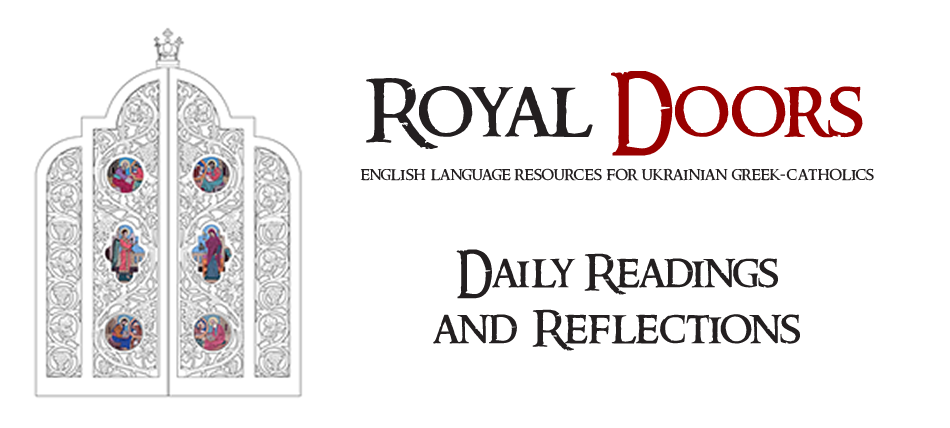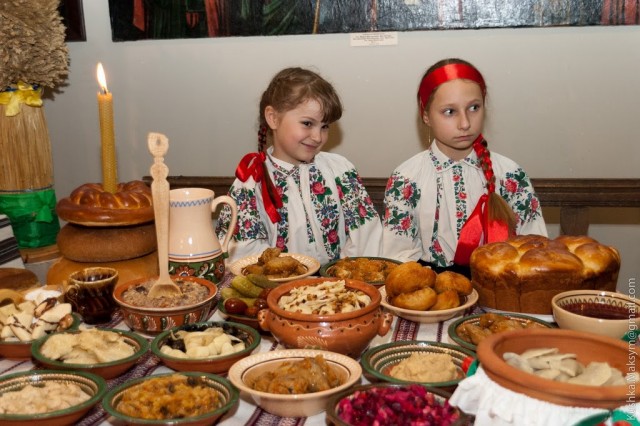by Brent Kostyniuk
O, Most merciful Lord and You, Son of Righteousness
We greet you with holy Christmas
Last year You gave us a harvest, You gave us goodness, You gave us health, You gave us wealth
Then help us this year so that it will be better.
Given Ukrainians’ love for ritual and symbolism, it is no surprise their Christmas celebrations are rich in traditions. Some traditions are purely religious ones, having evolved over the ten centuries since the people of Ukraine accepted Byzantine Christianity in 988. Others are much older. Born in ancient pagan times, they have been adapted to fit into a Christian way of life.
 The prayer which opens this column is one such tradition, reflecting not only Ukrainians’ ancient ties with the land, but their later love for Christianity. It is central to one of the first rituals to take place on vilia – Christmas Eve – although with a shift to urban living, it is seldom celebrated today. The words were prayed by a farmer, the hospodar – head of the household – as he carried a didukh in from the barn as vilia preparations were being made. The didukh was a sheaf of choice wheat, symbolizing the god of plenty. Likely, the original reference to “Son” was actually to the sun, the source of all goodness, and would have been part of mid-winter pagan celebrations. With the advent of Christianity, worship was transferred to Christ, but the traditional remained, in modified form. Having said the prayer, the hospodar would carry the didukh into the house, where it was placed in a spot of honour for the duration of Christmas celebrations. Some believed that the souls of the family’s ancestors were held in the didukh, allowing both living and dead to celebrate Christmas together.
The prayer which opens this column is one such tradition, reflecting not only Ukrainians’ ancient ties with the land, but their later love for Christianity. It is central to one of the first rituals to take place on vilia – Christmas Eve – although with a shift to urban living, it is seldom celebrated today. The words were prayed by a farmer, the hospodar – head of the household – as he carried a didukh in from the barn as vilia preparations were being made. The didukh was a sheaf of choice wheat, symbolizing the god of plenty. Likely, the original reference to “Son” was actually to the sun, the source of all goodness, and would have been part of mid-winter pagan celebrations. With the advent of Christianity, worship was transferred to Christ, but the traditional remained, in modified form. Having said the prayer, the hospodar would carry the didukh into the house, where it was placed in a spot of honour for the duration of Christmas celebrations. Some believed that the souls of the family’s ancestors were held in the didukh, allowing both living and dead to celebrate Christmas together.
As an aside, the Cambridge dictionary defines tradition as “a belief, principle or way of acting that people in a particular society or group have continued to follow for a long time…” Simply put, it has stood the test of time. Someone once came to me and said they had started a new family Christmas tradition. No, I thought, come back in 20 years and tell me about it. You may start something, but until it has been continued for a long time, it is not a tradition.
However, even if something has stood the test of time, circumstances change and traditions are modified. Quite obviously city dwellers have no opportunity to carry a didukh in from their barn. I remember my grandmother having a few stalks of wheat in a vase as a sort of urban didukh. Fewer and fewer Ukrainians bring didukhs into their homes as fewer and fewer of us live an agrarian lifestyle, let alone grow any of our own food at all. However, that is perhaps all the more reason to resurrect the custom. Each year, I plant a couple of rows of wheat in our backyard garden. It isn’t enough to produce a worthwhile amount of grain, but it is enough for a didukh. Thus, every Christmas Eve, I recite this prayer as I carry our didukh in from the garage where it had been stored since fall, keeping the tradition alive for our family.
Although many Ukrainian Christmas customs, such as Christmas Eve supper of 12 meatless dishes remain largely unchanged, others have been lost or simply cannot be celebrated. In 1942 the National Film Board of Canada (NFB) produced a movie about Ukrainian Christmas celebrations. Surprisingly it can be viewed on the internet here:
 Kutia, boiled wheat with honey and nuts, remains central to the sviat vechir – holy supper – on Christmas Eve. However, in the past, it was customary to throw a spoonful of kutia up at the ceiling. If a large amount stuck, it was an omen of a bountiful year to come. Today, this is hardly practical, unless redecorating or eviction are forthcoming. Similarly, the custom of spreading straw under the table to represent the manger where Christ lay is difficult to continue. Even more improbable is a custom which I had not heard of before seeing the NFB film. At the end of Christmas, the straw from under the table was taken to the front gate and spread on the ground in the shape of a cross. It was then set on fire. In pagan times, the resulting smoke was considered purifying. Livestock were led through it to prevent disease. Children would jump over the flames and smoke for a similar reason. By the time the NFB movie was made, the pagan associations were gone, however the ritual remained. Perhaps it was just an excuse for a good bonfire! Another new-to-me custom was that of young girls going outside on Christmas night and banging two spoons together to arouse local dogs. The girl’s future husband would come from the direction the first dog barked!
Kutia, boiled wheat with honey and nuts, remains central to the sviat vechir – holy supper – on Christmas Eve. However, in the past, it was customary to throw a spoonful of kutia up at the ceiling. If a large amount stuck, it was an omen of a bountiful year to come. Today, this is hardly practical, unless redecorating or eviction are forthcoming. Similarly, the custom of spreading straw under the table to represent the manger where Christ lay is difficult to continue. Even more improbable is a custom which I had not heard of before seeing the NFB film. At the end of Christmas, the straw from under the table was taken to the front gate and spread on the ground in the shape of a cross. It was then set on fire. In pagan times, the resulting smoke was considered purifying. Livestock were led through it to prevent disease. Children would jump over the flames and smoke for a similar reason. By the time the NFB movie was made, the pagan associations were gone, however the ritual remained. Perhaps it was just an excuse for a good bonfire! Another new-to-me custom was that of young girls going outside on Christmas night and banging two spoons together to arouse local dogs. The girl’s future husband would come from the direction the first dog barked!
Finally, a small tradition of my own, one which has earned the appellation being nearly 40 years old. Each Christmas I climb on to the roof our house and line the peak and front with Christmas lights. In spite of snow and ice, I have managed to string the lights every year without mishap. Two years ago our youngest daughter Victoria joined me in the ritual. Forty years and now two generations – it has become a family tradition.
Whatever your Christmas traditions, I pray you are able to celebrate them with joy and enthusiasm, surrounded by those you love.




